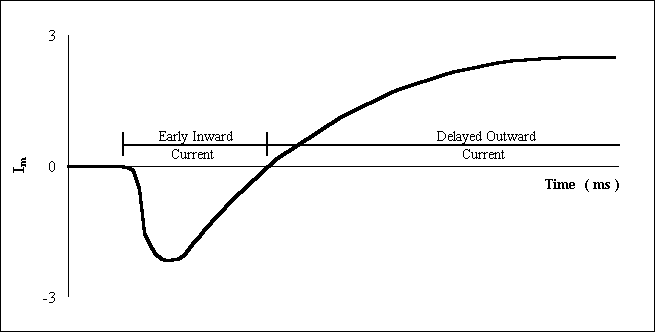Voltage Clamp Experiment
The results of a voltage clamp experiment are usually presented in the form of a graph of transmembrane current (Im) versus time (in ms). A typical tracing resulting from a voltage clamp simulation looks something like this:

Baseline (Im = 0) represents the situation when there is no net transmembrane current. Deflections from baseline in the tracing result from the presence of a net transmembrane current. By convention, downward (negative) deflections from baseline are attributed to an inward flux of + charge, while an upward (positive) deflection results from an efflux of + charge. Of course, a downward deflection could also result from the efflux of – charge, and an upward deflection could result from an influx of - charge; a simple voltage clamp experiment doesn’t differentiate between these two possibilities, and clever experimental design is required to discriminate between the two possibilities.
Early researchers identified two features of the voltage clamp graph that are of significance for our efforts to understand the ionic basis of the action potential. These are:
1. The Early Inward Current – as shown in the above illustration, this is usually a downward deflection from baseline, but depending on the clamping voltage, it may be an upward deflection ( = an outward current) or missing entirely. The maximum amplitude of this current is the datum of interest when conducting experimental tests of the Sodium Hypothesis.
2. The Delayed Outward Current – this is an outward current under nearly all experimental conditions. Its amplitude at some specified time (usually 5 ms or so) after application of the clamping voltage is the datum of interest when conducting experimental tests of the Potassium Hypothesis.
Bear in mind that what’s being recorded during the voltage clamp experiment is the output of the Feedback Amplifier, not the actual transmembrane flux of Na+ or K+ ions through voltage-gated channels. Thus, the voltage clamp experimental results actually provide us with only an indirect representation of events taking place in the membrane. Nevertheless, through insightful experimental design investigators have been able to infer a great deal about the molecular and ionic events involved in production of action potentials by excitable cells.